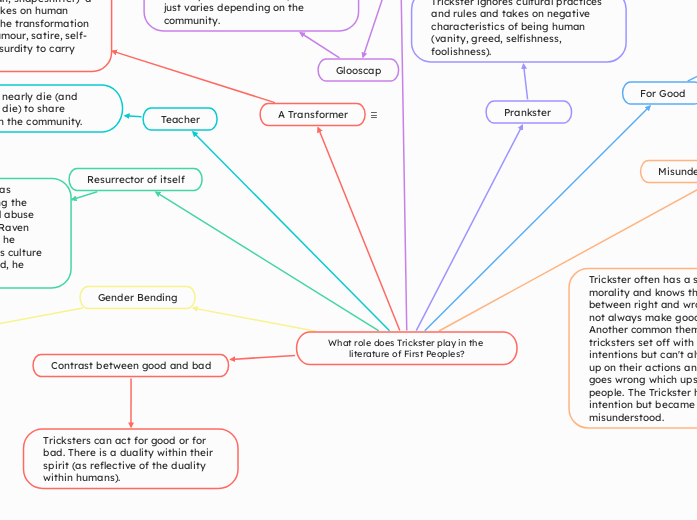What role does Trickster play in the literature of First Peoples?
A Transformer
"Trickster" has a diverse range of ideas (magician, enchanter, prankster, shaman, shapeshifter) a trickster often takes on human characteristics. the transformation often includes humour, satire, self-mocking, and absurdity to carry lessons.
Examples of Tricksters
Raven
Wesakejac
Nanabozo
A spirit that arrives during the winter. To help the People and the animals who were struggling during harsh winters. Nanabush sought help
Nanabush is a passionate advocate for their opinion and works to offer their opinions and wisdom. They are very knowledgeable and understand the worst the world has to offer but also see the purity of that around them.
Glooscap
The character of Glooscap is the same spirit as Nanabush, the name just varies depending on the community.
Miss Cheif Eagle Testicle
They are a two-spirited fluid persona used in the artwork of Kent Monkman to bring attention to how famous artwork continues to perpetuate a colonial narrative. Often Miss Chief is used to replace the "heroes" of these colonial-centered artworks to bring attention to the Indigenous perspective.
Gender and sexuality are not as binary as it is in European cultures and this persona represents that of a legendary being.
Prankster
Trickster ignores cultural practices and rules and takes on negative characteristics of being human (vanity, greed, selfishness, foolishness).
Vizenor, who is of the Minnesota Chippewa Nation, believes that the Trickster is a “doing, not an essence, not a museum being, not an aesthetic presence” (13).
For Good
Coyote saved the people as he tricked Bear into agreeing to have 6 months of summer and 6 months of winter because Grizzly wanted 22 months of winter but Coyote knew that the people could not survive for that long. He used his trickster abilities to make a deal and trick Grizzly into only getting 6 months (or "moons")
Nanabush went to the North to find help for winter's hardships on behalf of the People and the animals. He brought food to Winter who refused to accept his offerings. After Winter saw him enjoying his meal, he offered to taste it and enjoyed his meal. This convinced Winter to speak with the Sun to find balance over the seasons.
Teacher
Tricksters often nearly die (and occasionally do die) to share teachings within the community.
Tricksters commonly display poor behaviour to remind humans to not act in inappropriate ways.
Instead of directly telling children what to do, they used stories to guide them and have the characters act as good or bad examples.
Tricksters teach others about the importance of balance in life and how they should live balanced within the seasons.
Coyote teaches others that not everything needs to be fixed. Sometimes changing something that's already working has unintended consequences.
Trickster teaches others about reciprocity and showing appreciation for gifts (both gifts from others and the gifts found within yourself)
Resurrector of itself
Trickster was killed (as was Indigenous culture) during the years of assimilation and abuse from settlers. This made Raven rageful to see the people he created be mistreated. As culture recovered and persevered, he came back to life.
In some Indigenous stories, the Trickster figures can resurrect themselves after their death.
Misunderstood by the People
Coyote's intentions are often misunderstood by the People. He wanted to hold a great Salmon feast to share with others, but while he was organizing it the salmon he captured escaped. When the People arrived they thought that Coyote was playing a trick on them because he held a feast with no food. Coyote had good intentions, but the people did not believe him.
Coyote works to fix the wrong in this world, but often her "fixing" has unintended consequences. People are confused and upset that Coyote makes things bad when she is just trying to be helpful.
Trickster often has a sense of morality and knows the difference between right and wrong but does not always make good choices. Another common theme is that tricksters set off with good intentions but can't always follow up on their actions and something goes wrong which upsets the people. The Trickster had a good intention but became misunderstood.
Being misunderstood is lonely and leaves Tricksters to make poor decisions.
Gender Bending
Trickster is not any specific gender. It is beyond human gender constraints and may be different identities during different moments.
Contrast between good and bad
Tricksters can act for good or for bad. There is a duality within their spirit (as reflective of the duality within humans).
Coyote
Coyote is a manifestation of a trickster since "time immemorial"
A helper to people but could be a trickster. He is a transformer and can come back from the dead. He uses himself as an example of how humans behave (whether properly or improperly). He teaches others about the consequences of poor behaviour. Coyote serves as a physical reminder to behave properly as their story often ends with them being transformed into pieces of land which serve to remind others of his mistakes.
Coyote sees the greed of Columbus's actions and is confused by how he claims to have discovered Indigenous People. Coyote regrets creating people because they are not all good.
Coyote is the one who discovered the Indians. It is upsetting to itself when other people claim to have found them. She becomes tasked with building many parts of the world after making a big mistake. Her mistake was making people greed.
